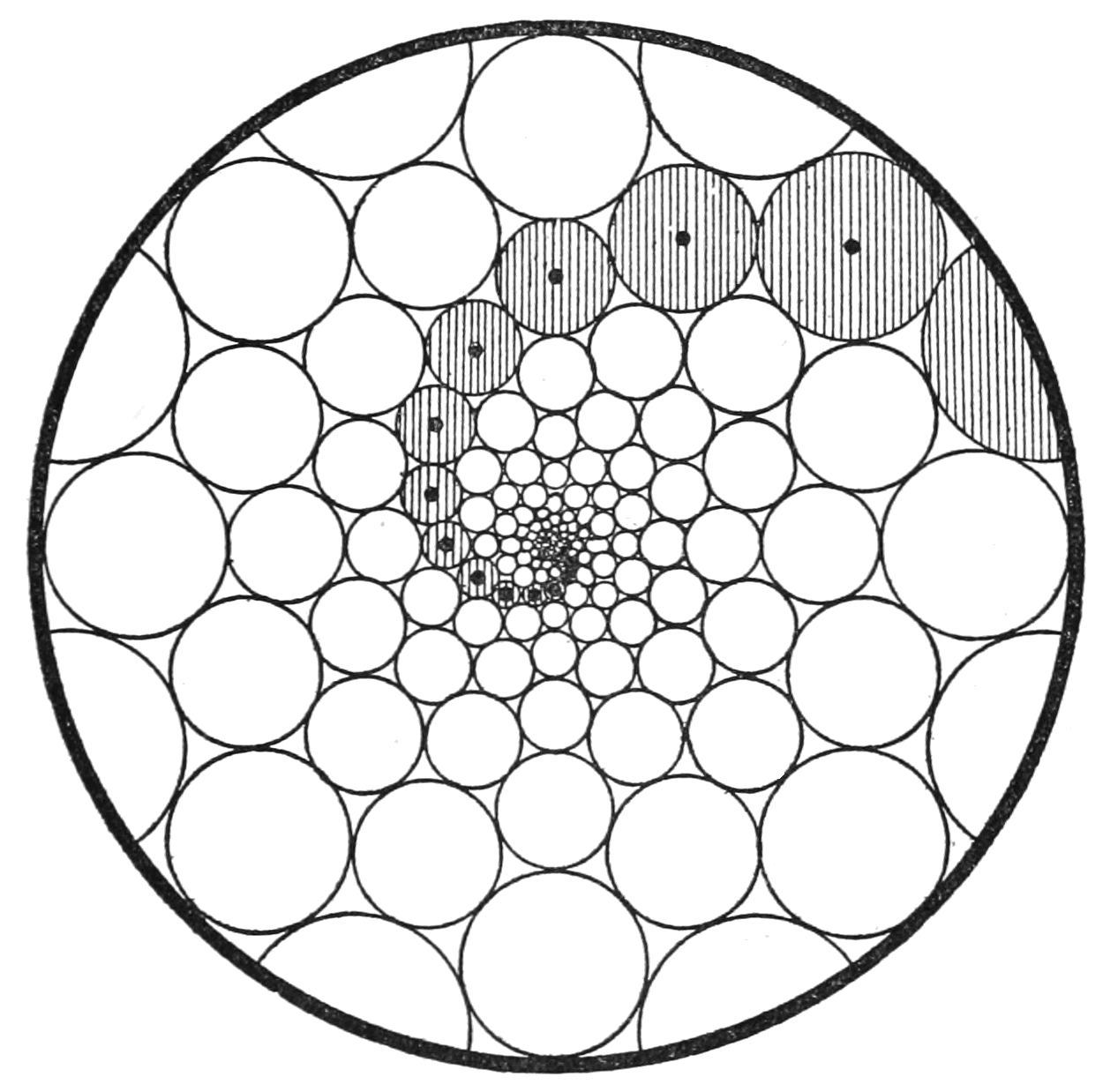
In the mathematics of
circle packing, a Doyle spiral is a pattern of non-crossing circles in the plane in which each circle is surrounded by a ring of six
tangent circles
In geometry, tangent circles (also known as kissing circles) are circles in a common plane that intersect in a single point. There are two types of tangency: internal and external. Many problems and constructions in geometry are related to tangen ...
. These patterns contain spiral arms formed by circles linked through opposite points of tangency, with their centers on
logarithmic spirals of three different shapes.
Doyle spirals are named after mathematician Peter G. Doyle, who made an important contribution to their mathematical construction in the late 1980s or However, their study in
phyllotaxis (the mathematics of plant growth) dates back to the early
Definition
A Doyle spiral is defined to be a certain type of
circle packing, consisting of infinitely many circles in the plane, with no two circles having overlapping interiors. In a Doyle spiral, each circle is enclosed by a ring of six other circles. The six surrounding circles are tangent to the central circle and to their two neighbors in the
Properties
Radii
As Doyle the only way to pack circles with the combinatorial structure of a Doyle spiral is to use circles whose radii are also highly For any such packing, there must exist three positive real numbers so that each circle of radius
is surrounded by circles whose radii are (in cyclic order)
Only certain triples of numbers come from Doyle spirals; others correspond to systems of circles that eventually overlap each
Arms

In a Doyle spiral, one can group the circles into connecting chains of circles through opposite points of tangency. These have been called ''arms'', following the same terminology used for Within each arm, the circles have radii in a doubly infinite
geometric sequence
In mathematics, a geometric progression, also known as a geometric sequence, is a sequence of non-zero numbers where each term after the first is found by multiplying the previous one by a fixed, non-zero number called the ''common ratio''. For ex ...
or a sequence of the same type with common multiplier
In most Doyle spirals, the centers of the circles on a single arm lie on a
logarithmic spiral, and all of the logarithmic spirals obtained in this way meet at a single central point. Some Doyle spirals instead have concentric circular arms (as in the stained glass window shown) or straight
Counting the arms
The precise shape of any Doyle spiral can be parameterized by three
natural number
In mathematics, the natural numbers are those numbers used for counting (as in "there are ''six'' coins on the table") and ordering (as in "this is the ''third'' largest city in the country").
Numbers used for counting are called ''Cardinal n ...
s, counting the number of arms of each of its three shapes. When one shape of arm occurs infinitely often, its count is defined as 0, rather The smallest arm count equals the difference of the other two arm counts, so any Doyle spiral can be described as being of where
and
are the two largest counts, in the sorted order
Every pair
with
 In the mathematics of circle packing, a Doyle spiral is a pattern of non-crossing circles in the plane in which each circle is surrounded by a ring of six
In the mathematics of circle packing, a Doyle spiral is a pattern of non-crossing circles in the plane in which each circle is surrounded by a ring of six  In a Doyle spiral, one can group the circles into connecting chains of circles through opposite points of tangency. These have been called ''arms'', following the same terminology used for Within each arm, the circles have radii in a doubly infinite
In a Doyle spiral, one can group the circles into connecting chains of circles through opposite points of tangency. These have been called ''arms'', following the same terminology used for Within each arm, the circles have radii in a doubly infinite  In the mathematics of circle packing, a Doyle spiral is a pattern of non-crossing circles in the plane in which each circle is surrounded by a ring of six
In the mathematics of circle packing, a Doyle spiral is a pattern of non-crossing circles in the plane in which each circle is surrounded by a ring of six  In a Doyle spiral, one can group the circles into connecting chains of circles through opposite points of tangency. These have been called ''arms'', following the same terminology used for Within each arm, the circles have radii in a doubly infinite
In a Doyle spiral, one can group the circles into connecting chains of circles through opposite points of tangency. These have been called ''arms'', following the same terminology used for Within each arm, the circles have radii in a doubly infinite